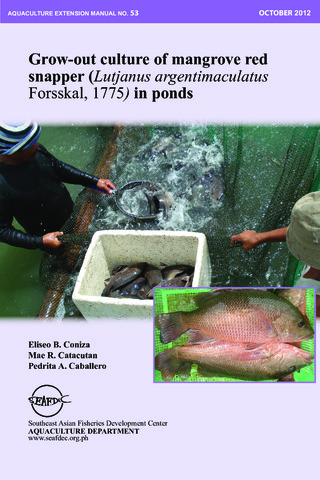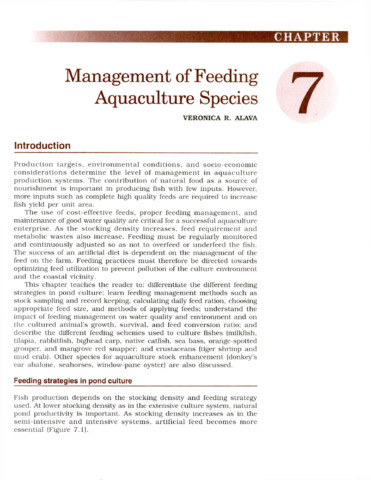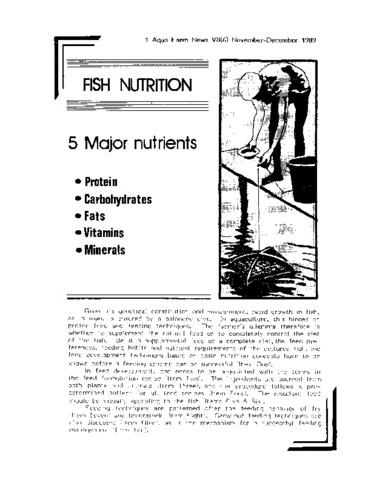Grow-out culture of mangrove red snapper (Lutjanus argentimaculatus Forsskal, 1775) in ponds
- Global styles
- MLA
- Vancouver
- Elsevier - Harvard
- APA
- Help

閲覧/開く
日付
2012Page views
19,228ASFA keyword
AGROVOC keyword
Taxonomic term
Metadata
アイテムの詳細レコードを表示する
Share
抄録
The mangrove red snapper is among the high-value marine fishes with great potential for export. Snapper is important to coastal fishery and ideal for aquaculture particularly in Southeast Asia. Grow-out culture of snapper are described - pond culture and culture in cages inside the ponds. In the pond culture, the whole area can be maximized and the available natural food can be utilized by snapper. In rearing snapper in cages inside the pond, fish sampling and harvesting are easily done and also in preventing of disease infection and securing of fish stocks during flooding. In both culture methods a good site would have a mangrove buffer space about 20-100 m that lies between the ponds and the source of water like river or sea. Pond soil with a good water retention property is desirable for dike construction. Water supply should be adequate year-round, free from pollutants and run-off flooding. Pond supplies, labor and technology should be available on the selected site which is also accessible to markets with peaceful locale. The pond for growing snapper should be prepared well in order to promote good growth of fish, to minimize pollution, and prevents the proliferation of pathogens. Stocking of healthy and larger uniform size juveniles will mean higher survival, faster growth and shorter culture period. Proper handling of juveniles during harvest, size-grading, counting, packing, transport, acclimation and stocking should be observed and should be done during the cooler part of the day. Recommended juveniles for grow-out is about 20-100 g average body weight (ABW) and stocking densities of 5,000/ha in ponds, and at 5 pcs/m3 or 5,000 pcs/ha when stocked in cages inside the pond. During culture, good water quality is maintained and when necessary the cleaning of net cages, repair of dike leaks and seepages, and aeration are to be considered. Snapper dietary protein is about 48-50%. The following are the factors to consider in the feeding management of snapper: total stock (pcs), survival (%), ABW (g), feed rate (% biomass), feed type, feed size, feeding frequency and time. Economic analysis based on 0.422 ha pond shows that feeds accounted for 60-67% and juveniles contribute 23-25% of the variable cost. The feed conversion ratios, return on investments, payback period and discounted benefit-cost ratios are 2.5 and 2.6; 203 and 43%; 0.46 and 1.76 yr; 1.4 and 1.2 for culture of snapper in pond and culture in cages inside the pond, respectively, are likewise acceptable.
Type
BookISSN
0115-5369シリーズ
Aquaculture extension manual; No. 53Format
28 pages : color illustrations.
Collections
Related items
Showing items related by title, author, creator and subject.
-
Management of feeding aquaculture species
Alava, Veronica R. (Aquaculture Department, Southeast Asian Fisheries Development Center, 2002)This chapter teaches the reader to: differentiate the different feeding strategies in pond culture; learn feeding management methods such as stock sampling and record keeping, calculating daily feed ration, choosing ... -
Fish nutrition
Carreon-Lagoc, Julia; Southeast Asian Fisheries Development Center, Aquaculture Department (Aquaculture Department, Southeast Asian Fisheries Development Center, 1989) -
Aquaculture development in Thailand
Sirikul, Boonsong; Luanprida, Somsak; Chaiyakam, Kanit; Sriprasert, Revadee (Aquaculture Department, Southeast Asian Fisheries Development Center, 1988)Aquaculture practised in Thailand is in the form of pond culture and cage culture in freshwater, brackishwater and coastal areas. The main species cultured include freshwater prawns, brackishwater shrimp, cockles, mussels, ...





